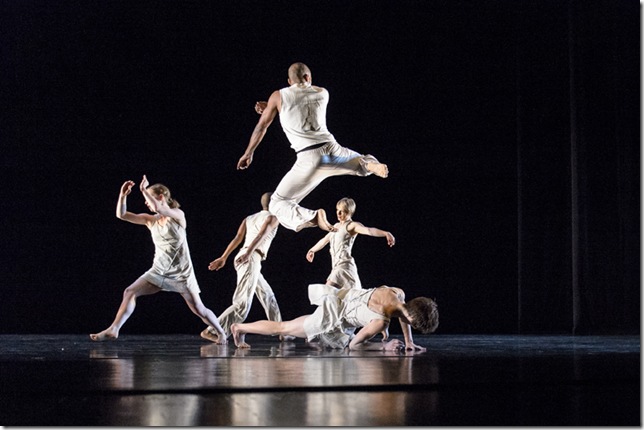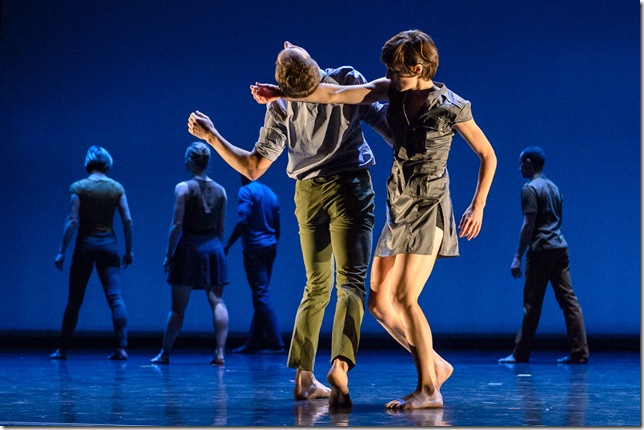By Tara Mitton Catao
On Friday night, the Duncan Theatre hosted the Ririe-Woodbury Dance Company, a Utah-based repertory dance troupe that continues to bear the name of the University of Utah professors who founded it over 50 years ago.
However, the program didn’t have the variety that a mixed repertory program usually encompasses. Growing from a local company to an internationally touring company, Ririe-Woodbury has a definite style of movement that is consistent in all its repertory works.
The exception was the standout of the evening, 50 Years (1996), created by Ann Carlson. In the program, Carlson is not just listed as choreographer but also as movement, language and visual designer. Right there, one can sense the scope of this rich work. Recently restaged, Carlson reworked 50 Years to incorporate her personal evolution as an artist in the past 15 years since the work was created with the individual personalities of the current company members. In a demanding rehearsal process, she re-created her multi-dimensional work and it is a taut and vibrant piece unlike any other on the program.
As one random, and often odd, moment after another tumbled together, a most peculiar but completely absorbing work was revealed. With this barrage of images, one gave up the need to make any kind of connections and just enjoyed the commitment and fullness that the performers gave to the work. Zany yet complete, it rolled along — engaging all the way — like skits in the entertaining improv TV show Whose Line Is It Anway?
An important element to the work was the impact of Carlson’s visual design. Looking like stars on a dark night, a slew of low-intensity lightbulbs were hung suspended above a large, white rectangle of canvas flooring. The dancers were dressed in a wild variety of almost Li’l Abner-cartoonish costumes which indicated their individuality but as they were all in the same dusty rose hue, the costumes also reinforced their mob mentality as they each initiated sounds and movements that rippled through the group.
What was particularly impressive about this work was the strength of the dancers’ delivery as they used their voices and acting skills to propel the work. They excelled as they created a tapestry of interwoven sounds using vocals, breath, laughter, and even sneezes punctuated with theatrical silences that had all the dynamics and rhythm of a good music score. All the while, they matched these skills seamlessly to their athletic dancing as they stretched and pulled the dynamics of the movement phrases with
The rest of the program, despite the fact that it was choreographed by four different people, was quite homogenous. In fact, the first three Ririe-Woodbury dances on the program could have been linked together as one work showing different, nuanced perspectives of being a couple.
Flirting with being too much of the same thing, it was the dancers whose performances staked out and claimed the right to explore in such detail the partnerships and partnering that shared similar overtones of origins in contact improvisation. The three works did serve the six-member company well as they introduced each dancer and highlighted their individual talent.
You and the Space Between (2013), choreographed by Miguel Azcue, segued nicely from the previous two duets. It started with an intimate duet which was cast with the two dancers who had not yet performed. Azcue added two more duets and soon the six-member company was dancing full throttle, interchanging partners.
Later, as the dancers wiggled and squirmed on the floor, our perspective was flipped with the aid of a live video filmed from overhead. What would have looked uninteresting and un-choreographed from the audience’s frontal view was now enhanced with the simultaneous projection of the dancers on a screen at the back of the stage. The audience was now privy to a completely different perspective as the dancers seemed to be rock-climbing now, slipping down and scaling up a giant wall.
The last work, Everything That Changes (2013), was choreographed by Daniel Charon, the newly appointed artistic director of Ririe-Woodbury Dance. It was his first creative interaction with his new company. A bit somber and beautifully defined by the lighting design of Cliff Walgren, the work contained more of the athletic and natural movement that seems to be Ririe-Woodbury’s house style.
Amidst its pedestrian gestures, relaxed feet, contact improv partnering and floor-rolling, the dancers were again focused in their intentionality and masterful in their movement impulse, sculpting moments of poignant stillness. Aided by the intermittent sounds of signals and radio static in the distance, Charon’s choreography created a mood of an environment that had malfunctioned, with humans interacting in a void.
Bradley Beakes, shirtless in a gray suit, was excellent in Gravitate (2004) which was choreographed by John Allen. Also eye-catching was Tara Roszeen McArthur in Everything That Changes and no words (2013), choreographed by Stephanie Nugent.

